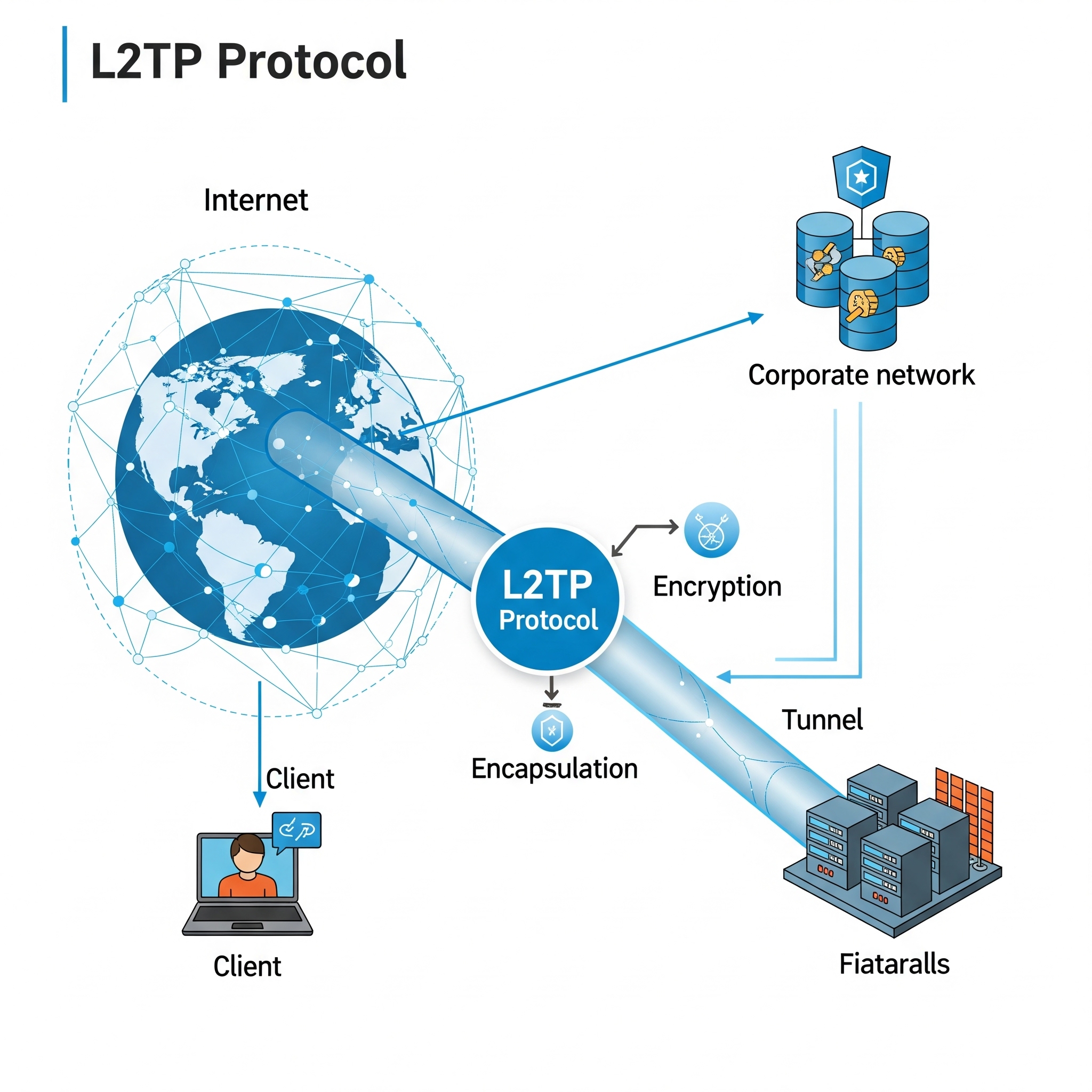In the world of internet security, acronyms fly fast and thick. But if you’ve ever manually configured a VPN on a Windows or Mac computer, you’ve likely come across L2TP. The Layer 2 Tunneling Protocol has been a workhorse of network tunneling for decades. But what is it, how does it work, and is it still relevant in an era of faster, more secure options like WireGuard?
This post dives into the technical yet fascinating story of L2TP, a protocol that solved critical problems in the 90s and whose legacy persists in our operating systems today.
What is L2TP and How Does It Work?
At its core, the Layer 2 Tunneling Protocol (L2TP) is a networking protocol that creates a “tunnel” to transport Layer 2 data frames, like Point-to-Point Protocol (PPP) frames, across a modern IP network like the internet.
Imagine you’re working from home. In the early days of the internet, you might have had to make a long-distance dial-up call to connect directly to your company’s network. L2TP was created to solve this. It ingeniously separates the
physical connection from the logical one. This allows a user to connect to a local Internet Service Provider (ISP), and then have their connection tunneled over the internet to their corporate network, saving on costs and simplifying access.
The L2TP architecture has two key components:
- L2TP Access Concentrator (LAC): This is the entry point of the tunnel. It physically terminates the user’s connection (like from a home router) and wraps their data into L2TP packets.
- L2TP Network Server (LNS): This is the exit point. Located on the private network (e.g., at the corporate office), it receives the tunneled data, unwraps it, and injects it into the local network as if the user were physically present.
This process can be initiated in two ways:
- Voluntary Tunnel: You, the user, actively initiate the tunnel from your computer using built-in L2TP client software. This is the common model for remote access VPNs.
- Compulsory Tunnel: Your ISP initiates the tunnel for you automatically. The user may not even know the tunnel exists. This model is often used by ISPs to provide wholesale access to other providers.
The Crucial Security Caveat: L2TP and IPsec
Here is the single most important thing to understand about L2TP:
by itself, it provides absolutely no encryption for your data. It is purely a tunneling protocol, not a security protocol. Any data sent over a “pure” L2TP connection is sent in cleartext, wide open to eavesdropping.
This is a deliberate design choice. To provide security, L2TP was designed to be paired with another protocol. That partner is almost universally the
IPsec suite. This combination is so common it’s typically referred to as a single entity:
L2TP/IPsec.
When you use L2TP/IPsec, a process called “double encapsulation” occurs:
- Your PPP data is first wrapped inside an L2TP packet.
- That entire L2TP packet is then wrapped again inside an IPsec packet for security.
IPsec provides the three pillars of security that L2TP lacks:
- Confidentiality: It encrypts the data using strong algorithms like AES.
- Integrity: It ensures the data hasn’t been tampered with in transit.
- Authentication: It verifies the identities of the client and server before the tunnel is even built, ensuring you’re connecting to a legitimate server.
L2TP/IPsec in the Modern VPN Landscape
While once a dominant force, L2TP/IPsec is now considered a legacy protocol. Modern alternatives have surpassed it in almost every way.
| Feature | L2TP/IPsec | OpenVPN | IKEv2/IPsec | WireGuard |
| Security | Moderate. Complex configuration can lead to errors. | Very High. Open-source and widely audited. | High. A more modern and streamlined version of IPsec. | Very High. Minimalist code and modern cryptography. |
| Performance | Moderate. Double encapsulation adds overhead. | Moderate to Slow. Can be CPU-intensive. | High. Faster and more streamlined than L2TP/IPsec. | Very High. The fastest protocol due to its lightweight design. |
| Stability | Moderate. Can be unstable on mobile networks. | High. Very stable but can be slow to reconnect. | Very High. Excellent for mobile devices that switch networks. | Very High. Maintains stable connections seamlessly. |
| Firewall Traversal | Poor. Uses fixed ports that are easily blocked. | Excellent. Can be disguised as HTTPS traffic, making it hard to block. | Poor to Moderate. Also uses fixed ports. | Good. Can use any port but lacks a TCP mode. |
| Configuration | Easy. Native support in most operating systems. | Difficult. Almost always requires third-party software. | Easy. Native support in many modern operating systems. | Easy. Simple key-based setup, but often needs a client app. |
Export to Sheets
The Verdict: Should You Still Use L2TP?
For new VPN setups, the answer is generally
no. Protocols like
WireGuard and IKEv2/IPsec offer superior speed, security, and stability.
So why does L2TP/IPsec persist? Its resilience is owed almost entirely to one factor:
native integration. It is built into nearly every major operating system, from Windows and macOS to Linux. This makes it a convenient, “lowest common denominator” choice for administrators who need to set up a VPN without forcing users to install third-party software.
However, the industry is moving on. Google has deprecated L2TP on Android, and hardware vendors are phasing it out in favor of IKEv2.
The story of L2TP is a classic tale of technological evolution. It was a brilliant and necessary solution for the problems of its time. Today, it serves as a legacy option, kept alive by the powerful inertia of being a built-in default. While it paved the way for modern VPNs, for your own security and performance needs, it’s time to look toward its more capable successors.
